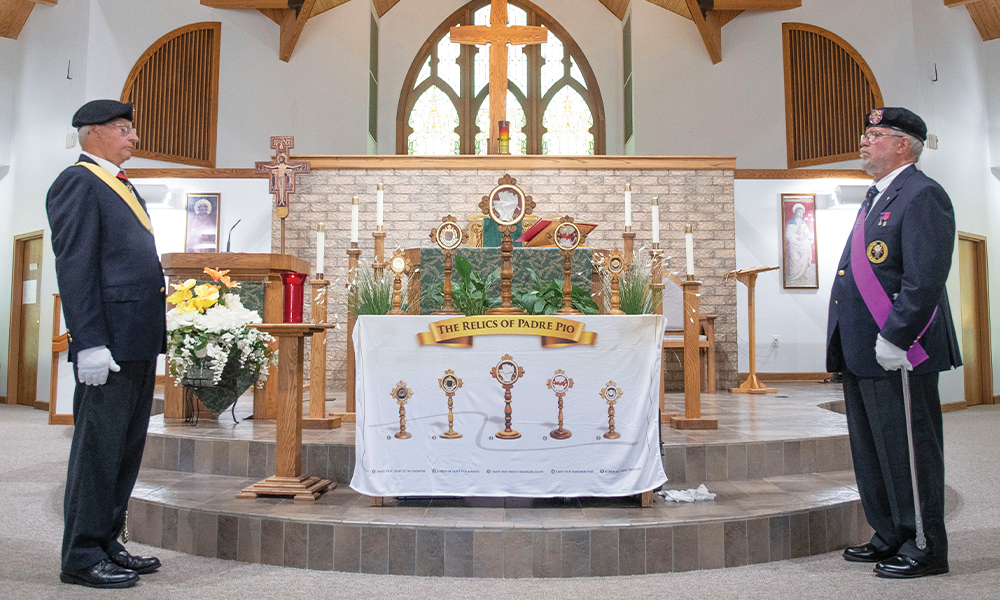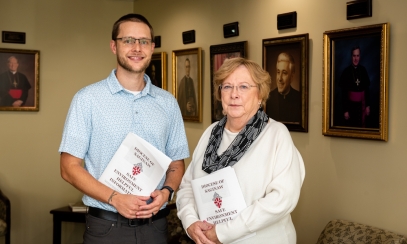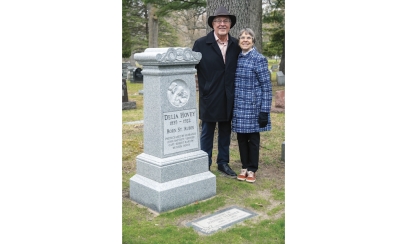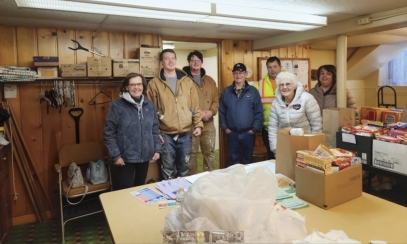
Pilgrims Flock to Birch Run to Venerate St. Padre Pio’s Relics
With eyes full of joy, Betty Zeestraten peered over her mask after spending time venerating the relics of St. Padre Pio on a recent Saturday at Ss. Francis and Clare in Birch Run.
With eyes full of joy, Betty Zeestraten peered over her mask after spending time venerating the relics of St. Padre Pio on a recent Saturday at Ss. Francis and Clare in Birch Run.
Until last fall when her pancreatic cancer recurred, Betty worked for eight years as a chaplain at Covenant Medical Center in Saginaw. Due to low energy from chemotherapy, Betty is unable to do much these days. She generally avoids large crowds, wears a mask in public, and watches Mass via livestream at the Cathedral of Mary of the Assumption and at Holy Spirit Parish in Saginaw.
But when she got the call from her friend, Sister Mary Lou Owczarzak, MSSp, on the morning of June 8 to see if she had the energy to go to venerate the relics of St. Padre Pio, she said yes.
“It’s the Lord who heals, but it doesn’t hurt to have heavenly people praying for us like Padre Pio,” said Betty, who was formerly a sister with the Sisters of St. Francis.
Betty has referred to her illness as a “pilgrimage,” and there are stops along the way—like the time spent venerating the relics of Padre Pio—that give her the “buoyancy” to continue the journey.
“I try not to focus on the struggle, but on the joy,” she said. “The choice is how to walk this pilgrimage, and I’ve kept joyful in the middle of all of it.”
Betty was among an estimated 350 to 400 people who began arriving before 8 a.m. on June 8 at Ss. Francis and Clare Parish in Birch Run to venerate the relics of St. Pio of Pietrelcina, an Italian priest better known as Padre Pio. He lived from May 25, 1887 to Sept. 23, 1968. One of the most beloved saints in the Church, Padre Pio spent most of his life at San Giovanni Rotondo monastery as a priest of the Order of Friars Minor Capuchin praying, celebrating Mass and hearing confessions for up to 18 hours a day. Padre Pio bore wounds similar to those of Christ (the stigmata) and had many spiritual gifts, including the gifts of healing, prophecy, bilocation (ability to appear in two places at the same time), discernment of spirits, ability to read hearts and an “odor of sanctity” that emanated from his wounds.
Throughout the day, a steady stream of people arrived from the Saginaw Diocese, as well as some from the Detroit area and as far north as Escanaba, more than five hours away. With reverence, people prayed silently in the pews and then approached the saint’s relics to venerate them as members of the Knights of Columbus District 4 Honor Guard stood watch. Most took rosaries, images of the saint and other items and gently touched them to reliquaries holding the relics of Padre Pio. The relics included a piece of the saint’s mantle, one of his fingerless gloves, a handkerchief, a lock of his hair and a crust of blood from one of his wounds.
Father David Jenuwine concluded the long-awaited day with a 4 p.m. Mass before a church filled with parishioners and visitors, and a homily that highlighted his favorite saint.
The pastor of Ss. Francis and Clare originally requested the relics from the Saint Pio Foundation in New York in 2021 while serving as temporary administrator for St. Cyril Parish in Bannister and St. Peter Parish in Chesaning. But due to COVID lockdowns, the relics stopped touring for a time. Then in January 2024, Father Jenuwine received a call from the foundation: when did he want Padre Pio’s relics to visit the parish? The first available date on his calendar and on theirs was Saturday, June 8— Father Jenuwine’s birthday.
So on the day he turned 62, Father Jenuwine spent time with his favorite saint. He could hardly think of a better birthday gift. Even so, the day held a personal challenge when Father Jenuwine found out that his elderly father was hospitalized after falling the night before. Despite wanting to be in two places at once, he remained at the parish and kept in touch with family throughout the day as he gave blessings, anointed the sick and heard more than the usual number of confessions. In the middle of it all, Father Jenuwine took time to sit in the back of the church, asking for his favorite saint’s intercession for his father. And he put Padre Pio’s advice—and now Father Jenuwine’s motto—to work: “pray, hope and don’t worry.”
That same famous Padre Pio quote (“pray, hope and don’t worry”) was emblazoned across the T-shirt that Sister Mary Lou wore to the event. Her sister Paulette bought the matching T-shirts after becoming captivated with the saint a few years ago.
Along with Paulette and long-time friend, Betty, Sister Mary Lou came to venerate St. Padre Pio’s relics and ask for his intercession for a few sick friends and relatives. The hope was that the saint would intercede for God to heal them and allow them to “feel his presence of peace.”
Padre Pio’s reputation for miracles of healing drew many to the parish.
Don Michalski, a member of the Resurrection of the Lord Parish in Sterling, drove 45 minutes to see relics of the saint he has admired for more than 30 years. Hoping to be healed from a “spiritual dryness” and wearing a large St. Benedict medal around his neck, the grand knight of the Standish Council of the Knights of Columbus did not know what to expect. But he returned home feeling relaxed, recharged and filled with an indescribable sense of peace and calmness.
“I felt like I went and saw an old friend,” Don said. “I feel like I have a part of Padre Pio with me now.”
Robert DeVriese, a member of Ss. Francis and Clare Parish, spent the day as an usher for the event, joyfully greeting everyone who arrived to venerate the relics. And while he has read about Padre Pio before, Robert said he now feels a deeper connection with him. Along with his family, Robert plans to listen to a CD about the saint.
Others, like parish maintenance professional Paul Hutchinson, did not know much about Padre Pio before arriving to venerate his relics. But after learning more about him from literature provided by the Saint Pio Foundation, Paul asked to borrow a book about the saint from his mother-in-law, a Padre Pio devotee, at Sunday dinner the next day. Paul now is captivated by stories about Padre Pio.
The day Paul met the saint by venerating his relics “will be something I will never forget.”
Making Padre Pio’s relics available to those who are unable to visit the saint’s tomb in San Giovanni Rotondo brings Richard Ruyack joy.
“Seeing their devotion brings me happiness,” said Richard, guardian of the relics for the Saint Pio Foundation. “It brings them spiritual peace, and it enhances their faith.”
What are relics and why do we venerate them?
Relics are physical items that have a direct connection with saints or Jesus. They are divided into three categories: first-class, which is part of the saint’s body; second-class, which is something the saint owned, wore or used; and third-class, which is anything that touched a first- or second-class relic.
We honor these reminders of holy men and women and believe that God can work through these items.
A relic invites a deeper relationship with a particular saint and establishes “an extra relationship within the Communion of Saints,” said Father David Jenuwine, pastor of Ss. Francis and Clare Parish in Birch Run.



